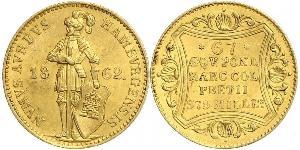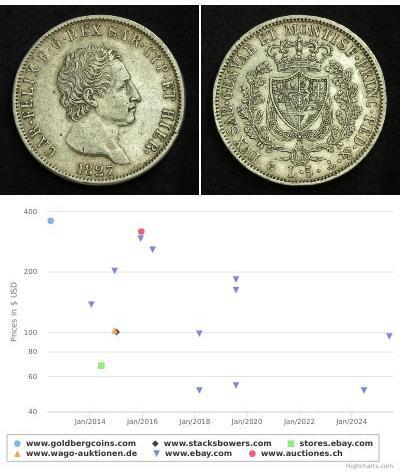1 Ducat
1872-B, Hamburg (Free Hanseatic City). Rare Gold "Knight" Ducat Coin. NGC MS-62!
Mint Year: 1872
Denomination: Ducat
Mint Place: Hannover (B)
Reference: Friedberg 1142, KM-589.
Condition: Certified and graded by NGC as MS-62! - Population 2/8!
Material: Gold (.986)
Weight: 3.49gm
Obverse: Knight standing left, holding longsword with right hand in front of his legs and shield with arms of Hamburg beneath him. Date (18-72) split in fields.
Legend: NVMVS AVREVS HAMBVRGENSIS.
Reverse: Inscription in five lines within ornate baroque frame.
Legend: * 67 * AEQV . POND . MARC . COL . PRETII 979 MILLEs.
The ducat coin was used as a trade coin in Europe from the later Middle Ages to the 19th century. Its most familiar version, the gold ducat or sequin containing around 3.5 grams (0.11 troy ounces) of 98.6% fine gold, originated in Venice in 1284 and gained wide international acceptance over the centuries. Similarly named silver ducatons also existed. The gold ducat circulated along with the Florentine florin and preceded both the modern British pound sterling and the United States dollar.
Hamburg, officially the Free and Hanseatic City of Hamburg; is the second-largest city in Germany. The official name reflects Hamburg's history as a member of the medieval Hanseatic League and a free imperial city of the Holy Roman Empire. Before the 1871 Unification of Germany, it was a fully sovereign city state, and before 1919 formed a civic republic headed constitutionally by a class of hereditary grand burghers or Hanseaten. Beset by disasters such as the Great Fire of Hamburg, north Sea flood of 1962 and military conflicts including World War II bombing raids, the city has managed to recover and emerge wealthier after each catastrophe.
In 1189 by Frederick I "Barbarossa" granted Hamburg the status of an Imperial Free City and tax-free access up the Lower Elbe into the North Sea. In 1265, a putative forged letter was presented to or by the Rath of Hamburg. This charter, along with Hamburg's proximity to the main trade routes of the North Sea and Baltic Sea, quickly made it a major port in Northern Europe. Its trade alliance with Lübeck in 1241 marks the origin and core of the powerful Hanseatic League of trading cities. On November 8, 1266 a contract between Henry III and Hamburg's traders allowed them to establish a hanse in London. This was the first time in history the word hanse was mentioned for the trading guild Hanseatic League. The first description of civil, criminal and procedural law for a city in Germany in German language, the Ordeelbook (Ordeel: sentence) was written by the solicitor of the senate Jordan von Boitzenburg in 1270. On August 10, 1410 civil commotion caused a compromise (German:Rezeß, literally meaning: withdrawal). It is the considered as the first constitution of Hamburg.

|
Beigetragen von:
anonymous 2024-03-12 |
|
||
|
||
|
||
|
||




 Deutsch
Deutsch Русский
Русский Українська
Українська English
English Italiano
Italiano Français
Français Español
Español 汉语
汉语













